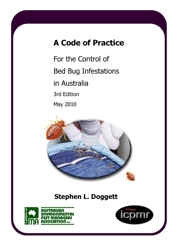Produced in Australia, and now into its third edition, this revised Code of Practice for the control of bedbug infestations is a must-have item for all pest controllers facing the challenge of any sort of bedbug infestation.
Stephen Doggett from the Department of Medical Entomology at Westmead Hospital, New South Wales, Australia is the principal editor of this Code which is published jointly with the Australian Environmental Pest Managers Association (AEPMA).
|
Says Stephen introducing the new Code: “One of the major aims of the Code of Practice is to protect pest managers and their clients from fraudulent practices and products. Sadly, however, with the resurgence of bedbugs the pest management and hospitality industries are seen as a potential cash cow by unscrupulous individuals out to make a fast buck. And there are all sorts of unsubstantiated reports of products claiming to control bedbugs when often there is little (or questionable) science to back up the claims. “If there is no scientific data produced by an independent body for a product then it is unlikely to be endorsed within the Bed Bug Code of Practice, ” he concludes. Although specifically designed for use in Australia, the Code has been adopted by other associations around the world – and reading this 87 page document you can understand why. The Code includes measures to control active bedbug infestations, how to minimise their spread and prevent further infestations. Sections cover risk assessment & management, how control measures should be employed for maximum effectiveness, their integration, limitation, contra-indication and documentation. An excellent section runs through the various treatment procedures ranging from good hygiene to chemical and non-chemical control. These are not just lists of available options, as for each there are practical recommendations written by people who have themselves been face-to-face with bedbugs. Copies are freely available in digital format from www.bedbug.org.au Or you can download your copy by clicking here. |
|
Author of the revised Code – Stephen Doggett
|



